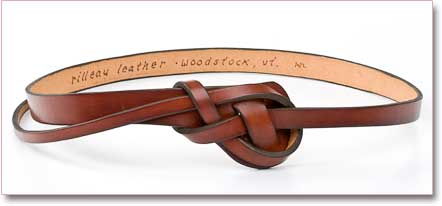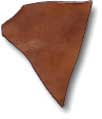 |
|||||||||||||||||||||||||||||||||||||||||||||||||||
|
|||||||||||||||||||||||||||||||||||||||||||||||||||
Rather than accept this circumstance and assume belt production without buckles was an impossibility, Roger Rilleau saw this instead as an enticing challenge…how to create a functional belt that needs no buckle? He rolled up his sleeves, approached the problem with his typically open mind and out of the creative process that ensued came Rilleau Knotted Belts! Pertinent to the development of these unique artwear items is another factor. As a designer of functional art, Roger consistently sought to simplify…to distill the object to its most elemental yet functional form. This can be seen in much of his work, and yet is perhaps nowhere better illustrated than in his Knotted Belts. Here we have a belt that requires no foreign material, is not weakened by rivets or stitches and yet is extremely functional. Since each belt is cut freehand, without a pattern, each one is a unique piece of wearable art with a form and character of its own…each hand signed. Made from thick but pliable cowhide all are hand finished and attains a rich natural luster that no artificial process can produce. They truly become more beautiful with each wearing. These belts are appropriate with both formal and casual attire, and perfectly suited to men or women. As fashionable now as they were five decades ago, the belts are a striking blend of aesthetics and practicality…form and function…a truly timeless design. Over the years they have become treasured additions to many collections of fine garments and accessories. THE KNOTTED BELTThe Knotted Belt is the original of the Rilleau buckle-less belts. The size of the knot is usually proportionate to the length, with the smaller knots accompanying the smaller waist sizes. ; and vice versa. This is also true of the width of the main "shaft" of the belts, but they range from 1" to 1 1/8" in general width. Approximately 8" of size adjustment is usually expectable from the belts and can sometimes be more. After the knot is tied there is 10" to 12" of extra length to the "tail". Usually this is tucked under the shaft of the belt near the hip. As you will see in the section with ordering information, these are available in a variety of colors. See below for options and ordering procedure. THE TAPERED BELT
As with the Knotted style, the size of the head and the width are usually proportionate to its length (waist size). Also as with the Knotted style, there is 6"– 8" of size adjustment to this design and the 10" – 12" of "tail" after the knot is tied. Click to see Belt Ordering Information (click again to close)
|
|||||||||||||||||||||||||||||||||||||||||||||||||||
| Home | History | Sandals | Belts | Bags | Specialty Items | Common Questions on Sandals Workmanship & Finishing | Contact Rilleau Leather | | Shop |
 The result allows the beauty of the raw material and the grace of its form to speak for itself.
The result allows the beauty of the raw material and the grace of its form to speak for itself. These were sometimes referred to in the 60's as "the Snake Belt". This design utilizes one set of vertical slots and ties in a graceful figure 8. Although it may seem somewhat complicated at first, the "knot" is actually very easy to learn and becomes automatic after only a few lacings. And for those convinced they won't figure it out, each Knotted Belt is accompanied by a very nice woodblock print that shows how this tie goes. It's also encouraging for most folks to hear that this knot is actually simpler than the knot we tie our shoes with…so if you can tie your shoes, you'll be OK with one of these belts.
These were sometimes referred to in the 60's as "the Snake Belt". This design utilizes one set of vertical slots and ties in a graceful figure 8. Although it may seem somewhat complicated at first, the "knot" is actually very easy to learn and becomes automatic after only a few lacings. And for those convinced they won't figure it out, each Knotted Belt is accompanied by a very nice woodblock print that shows how this tie goes. It's also encouraging for most folks to hear that this knot is actually simpler than the knot we tie our shoes with…so if you can tie your shoes, you'll be OK with one of these belts. Although it came second in the line of Rilleau Belts, the Tapered Belt has been around just about as long. It was offered to give a simpler and more elongated look. This design uses two sets of slots: one vertical and one set horizontal. The usual tying pattern passes the thong through the vertical slot, then down through the horizontal slot and then back through the vertical slots a second time, forming a simple loop.
Although it came second in the line of Rilleau Belts, the Tapered Belt has been around just about as long. It was offered to give a simpler and more elongated look. This design uses two sets of slots: one vertical and one set horizontal. The usual tying pattern passes the thong through the vertical slot, then down through the horizontal slot and then back through the vertical slots a second time, forming a simple loop.



